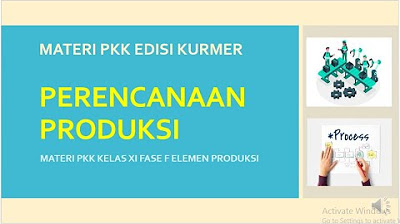Materi PKK Kelas XII SMK Bab 1 Produksi Massal Part 1
Summary
TLDRThis educational lecture focuses on mass production, a key topic in vocational education for SMK students in creative products and entrepreneurship. It explores the concept of mass production, its advantages like cost efficiency, high accuracy, and fast production, as well as its disadvantages, including limited product variety and high machinery costs. The lecture also delves into production planning, its goals, and methods for managing material flow, forecasting demand, and maximizing customer satisfaction. Additionally, it discusses the various types of production planning based on timeframes and the factors that influence both internal and external production decisions.
Takeaways
- 😀 Mass production is the process of producing large quantities of a product according to pre-established specifications, often involving the use of machines.
- 😀 Key characteristics of mass production include producing goods in large quantities, standardized products, low unit costs, and fulfilling market demand efficiently.
- 😀 The benefits of mass production include cost savings, time efficiency, high accuracy, and fast production rates due to advanced machinery.
- 😀 However, mass production has drawbacks such as rigid processes, limited product variety, high initial investment costs, and uncertain market success.
- 😀 Production planning involves determining what products will be produced, how many are needed, the production time, and the necessary resources.
- 😀 Production planning ensures the optimization of materials, labor, and equipment, and it aims to minimize costs while maximizing profits and customer satisfaction.
- 😀 Proper production planning helps minimize production delays, ensures the quality of products, and prevents waste through efficient resource management.
- 😀 There are three levels of production planning: long-term (over a year), medium-term (2-3 years), and short-term (within a year).
- 😀 Internal factors such as machine capacity and workforce productivity, along with external factors like government policies and inflation, influence production planning.
- 😀 Key steps in production planning include product research and development, generating product ideas, designing products, setting production scale, and determining optimal resource usage.
Q & A
What is mass production?
-Mass production refers to the large-scale production of standardized products, typically using automated machinery, with the goal of producing a high volume of uniform products to meet market demand.
What are the key characteristics of mass production?
-The key characteristics of mass production are large-scale production, standardization of products, cost efficiency, minimal product variation, and the use of advanced machinery.
What are the main advantages of mass production?
-The main advantages include cost savings due to bulk production, time efficiency from machine automation, high accuracy with reduced human error, and fast output, which allows for quick market distribution.
What are some disadvantages of mass production?
-Disadvantages include inflexibility in adapting designs, lack of product variety, high initial costs for machinery and maintenance, and the risk that mass-produced goods may not always succeed in the market.
How does mass production help reduce per-unit costs?
-Mass production reduces per-unit costs by producing large quantities of products, allowing companies to buy raw materials in bulk, reduce labor costs through automation, and optimize the use of machinery.
What is the role of production planning in mass production?
-Production planning ensures that all resources—such as materials, labor, and machinery—are used efficiently to meet production goals, maintain schedules, and fulfill customer demands.
How does production planning optimize costs and improve product quality?
-By forecasting demand and organizing resources effectively, production planning minimizes waste, ensures timely delivery, and helps maintain consistent product quality by controlling the entire production process.
What are the three levels of production planning?
-The three levels of production planning are long-term planning (1-5 years), which focuses on capacity and expansion; medium-term planning (2-3 years), which covers material and labor needs; and short-term planning (less than a year), which deals with daily operations.
What are internal and external factors that affect production planning?
-Internal factors include the company's resources, such as machinery, labor productivity, and material procurement capabilities. External factors involve influences outside the company, such as government policies, market inflation, and natural disasters.
How does automation in mass production impact labor?
-Automation in mass production can reduce the need for manual labor by replacing workers with machines, which can lead to job displacement but also increases efficiency and reduces production costs.
Outlines

Dieser Bereich ist nur für Premium-Benutzer verfügbar. Bitte führen Sie ein Upgrade durch, um auf diesen Abschnitt zuzugreifen.
Upgrade durchführenMindmap

Dieser Bereich ist nur für Premium-Benutzer verfügbar. Bitte führen Sie ein Upgrade durch, um auf diesen Abschnitt zuzugreifen.
Upgrade durchführenKeywords

Dieser Bereich ist nur für Premium-Benutzer verfügbar. Bitte führen Sie ein Upgrade durch, um auf diesen Abschnitt zuzugreifen.
Upgrade durchführenHighlights

Dieser Bereich ist nur für Premium-Benutzer verfügbar. Bitte führen Sie ein Upgrade durch, um auf diesen Abschnitt zuzugreifen.
Upgrade durchführenTranscripts

Dieser Bereich ist nur für Premium-Benutzer verfügbar. Bitte führen Sie ein Upgrade durch, um auf diesen Abschnitt zuzugreifen.
Upgrade durchführenWeitere ähnliche Videos ansehen

COMPANY PROFILE SMKN 62 - 2023

RUANG LINGKUP MATA PELAJARAN PROJEK KREATIF DAN KEWIRAUSAHAAN

Kelas Industri Alfamart Kompetensi Keahlian Bisnis Daring dan Pemasaran SMK Negeri 1 Bawang

#PKK 1 DESAIN PRODUK - Produk Kreatif dan Kewirausahaan

MATERI PKK KURMER : PERENCANAAN PRODUKSI

PROFIL KEPALA SEKOLAH SMK NEGERI 1 WONOSARI
5.0 / 5 (0 votes)
